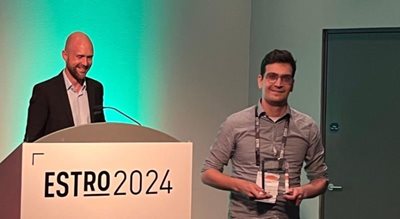Time-resolved analysis of clinical dose metrics for HDR brachytherapy error detection
Teun van Wagenberg, Gabriel Paiva Fonseca, Robert Voncken, Maaike Berbee, Evert van Limbergen, Frank Verhaegen
ESTRO 2024 Congress report
High-dose-rate (HDR) brachytherapy could benefit from in-vivo dosimetry to enable dosimetric validation of treatments and error detection. Several different approaches are currently under development. These range from direct measurements with internal or external dosimeters to source tracking approaches, for example using an external imaging panel.
Such a source tracking measurement usually provides the positions of the source in a specific coordinate system over time. This can be compared with the planned values and used to calculate differences in dwell time and source position. However, from a clinical perspective, this information is difficult to interpret. The delivered dose is more relevant information, as this tells us what effect a specific deviation from the treatment plan has on the patient. This effect is very difficult to determine from just a difference in dwell time and source position, as HDR brachytherapy plans can be complex and the total contribution of a dwell position depends on its location relative to the target and organs-at-risk.
At the ESTRO 2024 congress, we presented the dose calculation approach that was implemented for our source tracking system. Besides calculating the dose delivered by using TG-43 guidelines, we added some novel features to this tool. One of these was the ‘uncertainty band’, which is an estimation of the influence of measurement inaccuracy on the final dose. Such bands can be visualised in dose-volume histograms to show how much deviation can be expected just from the measuring approach, and thus help with decision-making.
Another functionality of the tool is the analysis of time-resolved clinical dose metrics. We found that by calculating dose metrics after every dwell position (such as the D90%-planning target volume), we could track the treatment over its course. This was useful, as we could compare these metrics to their planned values after every dwell position, and thus we could evaluate them intra-fraction. Another novel feature was that we could use the dose that was expected from future dwell positions to predict the final value for a dose metric after every dwell position. This enabled us to set thresholds for these dose metrics that allowed for real-time error detection.
We think that by using source tracking and our dose calculation tool, we can give a good estimation of the dose that has been delivered to the patient. Moreover, we believe that it could be used to monitor the progress of the treatment in real time and therefore the user might be able to interrupt the treatment if a significant deviation occurred. This approach was developed for our source tracking method, but it should work for any other method. Therefore, we hope it inspires others to start to use similar methods, in order to improve treatment verification for HDR brachytherapy and ultimately to make brachytherapy treatments safer.
Teun van Wagenberg
Department of Radiation Oncology (Maastro), GROW Research Institute for Oncology and Reproduction, Maastricht University Medical Centre+, Maastricht, The Netherlands

Teun van Wagenberg (right) and Maarten ter Mors, Head of Brachy Solutions Elekta